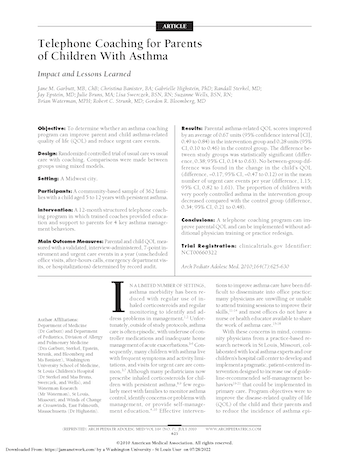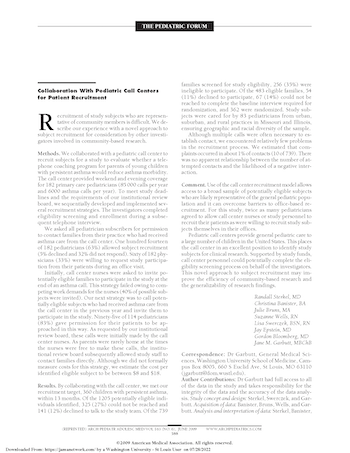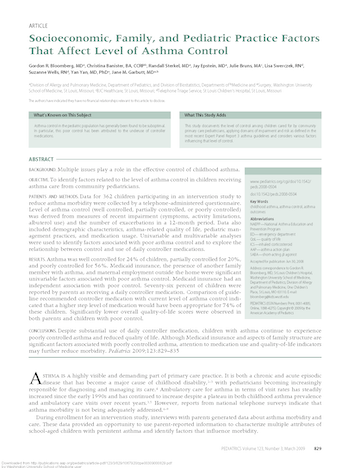Asthma – Telephone Coaching
2004-2009
A telephone coaching intervention to improve asthma self-management behaviors
May 1, 2013
Swerczek LM, Banister C, Bloomberg GR, Bruns JM, Epstein J, Highstein GR, Jamerson PA, Sterkel R, Wells S, Garbutt JM. A telephone coaching intervention to improve asthma self-management behaviors. Pediatr Nurs. 2013 May-Jun;39(3):125-30, 145. PMID: 23926751.
Long recognizing that asthma, one of the most common chronic childhood diseases, is difficult to manage, the National Asthma Education Prevention Program developed clinical practice guidelines to assist health care providers, particularly those in the primary care setting. Yet, maintenance asthma care still fails to meet national standards. Therefore, in an attempt to improve and support asthma self-management behaviors for parents of children 5 to 12 years of age with persistent asthma, a novel nurse telephone coaching intervention was tested in a randomized, controlled trial. A detailed description of the intervention is provided along with parent satisfaction results, an overview of the training used to prepare the nurses, and a discussion of the challenges experienced and lessons learned.
Telephone coaching for parents of children with asthma: impact and lessons learned
July 1, 2010
Garbutt JM, Banister C, Highstein G, Sterkel R, Epstein J, Bruns J, Swerczek L, Wells S, Waterman B, Strunk RC, Bloomberg GR. Telephone coaching for parents of children with asthma: impact and lessons learned. Arch Pediatr Adolesc Med. 2010 Jul;164(7):625-30. doi: 10.1001/archpediatrics.2010.91. PMID: 20603462.
Objective
To determine whether an asthma coaching program can improve parent and child asthma-related quality of life (QOL) and reduce urgent care events.
Design
Randomized controlled trial of usual care vs usual care with coaching. Comparisons were made between groups using mixed models.
Setting
A Midwest city.
Participants
A community-based sample of 362 families with a child aged 5 to 12 years with persistent asthma.
Intervention
A 12-month structured telephone coaching program in which trained coaches provided education and support to parents for 4 key asthma management behaviors.
Main Outcome Measures
Parental and child QOL measured with a validated, interview-administered, 7-point instrument and urgent care events in a year (unscheduled office visits, after-hours calls, emergency department visits, or hospitalizations) determined by record audit.
Results
Parental asthma-related QOL scores improved by an average of 0.67 units (95% confidence interval [CI], 0.49 to 0.84) in the intervention group and 0.28 units (95% CI, 0.10 to 0.46) in the control group. The difference between study groups was statistically significant (difference, 0.38; 95% CI, 0.14 to 0.63). No between-group difference was found in the change in the child’s QOL (difference, -0.17; 95% CI, -0.47 to 0.12) or in the mean number of urgent care events per year (difference, 1.15; 95% CI, 0.82 to 1.61). The proportion of children with very poorly controlled asthma in the intervention group decreased compared with the control group (difference, 0.34; 95% CI, 0.21 to 0.48).
Conclusions
A telephone coaching program can improve parental QOL and can be implemented without additional physician training or practice redesign.
Collaboration with pediatric call centers for patient recruitment
June 1, 2009
Sterkel R, Banister C, Bruns J, Wells S, Swerczek L, Epstein J, Bloomberg G, Garbutt JM. Collaboration with pediatric call centers for patient recruitment. Arch Pediatr Adolesc Med. 2009 Jun;163(6):588-9. doi: 10.1001/archpediatrics.2009.73. PMID: 19487619.
Recruitment of study subjects who are representative of community members is difficult. We describe our experience with a novel approach to subject recruitment for consideration by other investigators involved in community-based research.
Socioeconomic, family, and pediatric practice factors that affect level of asthma control
March 1, 2009
Bloomberg GR, Banister C, Sterkel R, Epstein J, Bruns J, Swerczek L, Wells S, Yan Y, Garbutt JM. Socioeconomic, family, and pediatric practice factors that affect level of asthma control. Pediatrics. 2009 Mar;123(3):829-35. doi: 10.1542/peds.2008-0504. PMID: 19255010; PMCID: PMC2723164.
Background
Multiple issues play a role in the effective control of childhood asthma.
Objective
To identify factors related to the level of asthma control in children receiving asthma care from community pediatricians.
Patients and Methods
Data for 362 children participating in an intervention study to reduce asthma morbidity were collected by a telephone-administered questionnaire. Level of asthma control (well controlled, partially controlled, or poorly controlled) was derived from measures of recent impairment (symptoms, activity limitations, albuterol use) and the number of exacerbations in a 12-month period. Data also included demographic characteristics, asthma-related quality of life, pediatric management practices, and medication usage. Univariable and multivariable analyses were used to identify factors associated with poor asthma control and to explore the relationship between control and use of daily controller medications.
Results
Asthma was well controlled for 24% of children, partially controlled for 20%, and poorly controlled for 56%. Medicaid insurance, the presence of another family member with asthma, and maternal employment outside the home were significant univariable factors associated with poor asthma control. Medicaid insurance had an independent association with poor control. Seventy-six percent of children were reported by parents as receiving a daily controller medication. Comparison of guideline recommended controller medication with current level of asthma control indicated that a higher step level of medication would have been appropriate for 74% of these children. Significantly lower overall quality-of-life scores were observed in both parents and children with poor control.
Conclusions
Despite substantial use of daily controller medication, children with asthma continue to experience poorly controlled asthma and reduced quality of life. Although Medicaid insurance and aspects of family structure are significant factors associated with poorly controlled asthma, attention to medication use and quality-of-life indicators may further reduce morbidity.


